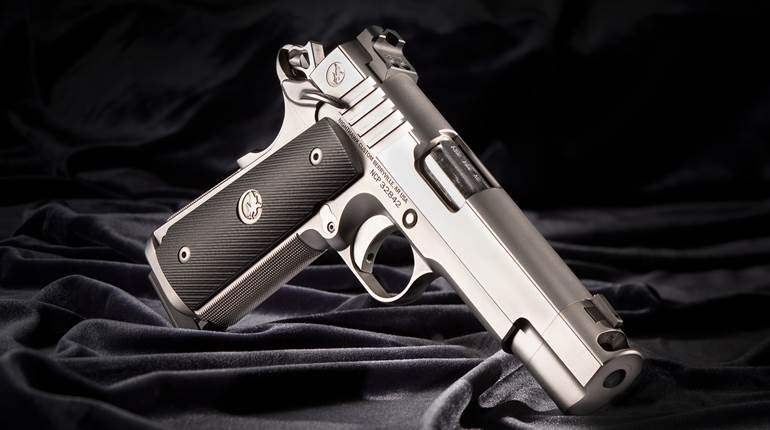
If you love to pull triggers then you owe it to yourself to give 3-gun shooting a try. This fast-growing sport will challenge your shooting skills with just about every scenario you can think of, from long-range precision rifle work to up-close and blisteringly fast shooting with a rifle, pistol and shotgun. It's all on the clock, and the shooter who hits all the targets the fastest wins the match.
This sport moves fast, burns a lot of ammunition and is more fun than you thought possible. It's also great training, because 3-gun builds shooting skills that are useful for self-defense and hunting. I am addicted to 3-gun and on a quest to improve, which means picking the brain of anybody who is better than me. Trust me, that's a very long list. In June 2008 I attended the Midwest 3-gun championships hosted by FNH USA, and I was lucky enough to spend time with some of the top shooters in the world, learning their secrets firsthand. Here is a little of what they taught me.
The Duck Walk
In my first 3-gun match there was a pistol stage that had to be shot while moving. My brain seized up, and I flashed back to the devastating stage disqualification or "DQ" I endured for taking a step with a loaded gun in a big Cowboy Action Shooting match. Instinct took over, and I stopped moving every time I started to pull the trigger. Because I was new, the Range Officer cut me some slack, but after three or four violations he figured enough was enough and issued a procedural penalty for not moving while shooting.
Even more important, I found when practicing later that I couldn't hit anything while walking anyway because the sights were bouncing all over the target. Larry Wayland shoots on the FNH USA team and he gave me some tips. "We call it the duck walk," he said, much to his regret later. We filmed this for "American Rifleman Television," and it ran the night before the DPMS/Brownells Tri-Gun challenge in August. Every time it was his turn to shoot, his buddies heckled him with loud quacks.
But, the duck walk works. The idea is to bend your knees and walk with short baby steps, heel to toe. The key is to remove movement from your shoulders and upper body. It really clicked for me when Wayland said to "walk like I was on slippery ice." I still need some practice, but my sights stayed steady and my hit ratio went up dramatically.
Loading Your Scattergun
In the Tactical Optics class in which I shoot, the shotgun is limited to nine-round-magazine capacity. The second stage I shot in the Midwest 3-Gun Championship match was all shotgun and required 39 shots ... if there were no misses. I thought I was hot stuff with a shotgun, but I blew that stage because I tried to go too fast, outran my abilities and had some misses. This is a common problem with any gun during a match. Shooters try to go too fast and start missing. Control that, shoot to your ability and the speed will follow. Besides, as any shooter knows, a fast miss is still a miss. But the single biggest reason I blew that stage is because I was too slow when reloading the shotgun.
"The secret to winning with a shotgun is not necessarily in the shooting, but in loading," James Darst, a Team DPMS shooter, told me. "Any good shooter can empty all nine shots in a few seconds, but reloading takes time for everybody. Learn to load your shotgun fast and you will improve your scores. In fact, the guy who loads his shotgun the fastest often wins the match. It is that important. " To start, Darst showed me two drills. First with the shotgun "shot dry" and the bolt locked back. I would load one shell, shoot it, then load another. Then he had me load two shells, fire one and reload one to practice loading when the gun still has some ammunition on board. This builds skill and muscle memory for loading in both scenarios. Muscle memory is very important. If your body is familiar with the movement, it will do it well and without hesitation, which is why practice is important. He showed me how to grab the shell and position it in my hand to load it into the shotgun with one smooth move. "When you load, don't lay the shell on the gun and then move your hand back to push it in. Position the shell so when your hand puts it in the gun, your thumb is on the back of the shell and you can push it with one smooth motion. This saves a few tenths of a second with every shell you load, and they all add up," said Darst. We practiced loading with the gun at my shoulder for a fast extra shot with a shell in the barrel. Then we practiced with the gun upside down for a complete reload. I found it best to position the shotgun waist high for this, the butt tucked under my arm and the fore-end supported by my left hand. The right hand does the loading.
We timed my loading from the three different shell holders. The first was from a Tri-Star side-saddle mounted on the gun's receiver. Then I practiced from a Blackhawk forearm shotshell holder on my left arm and finally from a California Competition six-shell, belt-mounted holder, which came from Brownells. While it's important to practice all three methods—as you will use them all in a long stage like that 39-shot shotgun marathon—I found that I was fastest from the forearm shell holder. So when I need only a few shells for a reload in a stage, I go there first.
The next thing we worked on is strategy. I found that I was running the gun dry too often and wasting time before I discovered I was out of ammunition. In fact, one time I shot a popper target that launched a clay pigeon when it fell, only to discover I had fired my last shot at the knock-down target. I watched the clay bird rise and fall and hit the ground intact, as I struggled to load my empty shotgun. That means a penalty for failure to neutralize and another for failure to engage. Other times I would have the gun fully reloaded while still holding loose shells in my hands. I had to waste time putting them back in a holder, or drop them and risk running out of shells on the high-shot count stages.
"Count your shots," Darst told me. "You should know how many are in the shotgun at any given moment. Reload what you shot, so if you shot five, reload five. But remember, that's not always necessary. If the stage only has six targets left and you have four shells in the gun, why waste time loading five more shells? Load two and shoot the targets, but don't miss. If you think you might miss, load three. Always be counting and always be thinking."
Rocking And Rolling With Your Rifle
It's amazing to watch the top competitors with a rifle. Some of them can run close targets so fast the rifle sounds like a machine gun. With so many rifle targets in a match requiring double taps—or in the case of the Coast Guard Academy's match I recently shot in Connecticut, triple taps—it's important to be able to control your rifle and keep it on target. Part of that is in the equipment and in having a good, recoil-controlling muzzle brake. But equipment is never a substitute for skill, and technique is important too.
Bruce Piatt is one of the top 3-gun shooters in the world, and he spent a little time teaching me a few tricks about rifle shooting. "Most shooters stand up too straight when they are shooting," he said. "Even though a .223 Remington cartridge has light recoil, it's still enough to throw you off for a fast next shot. Pull the rifle tight and snug into your shoulder and then lean forward into the gun so that your weight is forward of the center of gravity. Put your body weight behind the stock. That way it's harder to push you back. If you are standing up straight, your body weight is pretty much centered—it's easy to rock you back—but when you lean forward your weight is hanging forward of the center of balance, and it is much harder for the recoil to push you back.
"Reach out and grip your rifle at the end of the handguard. Too many shooters hold the rifle in front of the magazine well, which is a mistake. Stretch your hand out and grip the rifle out in front. This forward grip position also puts your hand out closer to the muzzle, which reduces the length of the fulcrum of the barrel when it tries to rise in recoil and gives you more power to control the gun," said Piatt. "By the way," Piatt added, "These things also apply to shooting your shotgun."
Transition Time
Deb Cheek is another Team DPMS shooter who is very willing to share her knowledge. She showed me some tricks for transitioning from one gun to the next in those stages with multi-gun requirements. "Think it out ahead of time," she said. "Plan in your head what you are going to do so you have best use of movement. For example, if you are switching from a long gun to a pistol, use your left hand (if you are right-handed) to stage the long gun in the safe location while your right hand is drawing your pistol. The key is economy of motion and to always have both hands doing something. Plan out how you will shoot the entire stage and what each hand will be doing at any given time. Go over that plan in your head until you have it memorized and then stick with the plan."
"Your hands follow your eyes, so as you transition to the next target, keep your eyes focused on the target. Bring your gun to your eyes and start shooting when they all are in alignment. Plan your reloads, especially with the shotgun. It may make sense to stop and load the gun well before it's empty. You don't want to be caught with an empty gun at the wrong time. I sort of remember seeing a guy standing with an empty gun as some aerial clay targets fell to the ground unbroken. Come to think of it, he looked a lot like you!" said Cheek.
One last tip: If you don't practice, all this means nothing. That's from me, but the pros agree. I was struggling to find a close for the "American Rifleman Television" episode when Piatt walked by. I called out, "I need help, give me a quote!" "Three times the guns—three times the fun!" He shouted out without breaking stride. That about covers it.






































